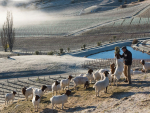Methane campaign is 100% politics
OPINION: We are endlessly told that livestock are responsible for half of New Zealand's total emissions.
The soil food web can be thought of as the soil biome.
Like humans have a gut biome that breaks down food, the soil too has a biome that breaks down organic matter. A healthy soil biome can provide plants with a constant flow of nutrients from soil organic matter and the mineral fraction of soil.
Fungi and bacteria release nutrients from sand, silt and clay in soil, making nutrients available to plants in a process that the plant controls. This means that plants get access to the nutrients they need exactly when they need them.
Having access to necessary nutrients helps plants to protect themselves from pests and disease attack, drought and flooding.
Figure 1 gives an overview of the soil food web and illustrates some of the interactions within and between different trophic levels. The first level contains photosynthesisers. The plants or their products, in this case root exudates, are consumed and sometimes supported by the second-level microorganisms (decomposers, mutalists, pathogens, root feeders and parasites). At the third level primary carnivores - predators, shredders and grazers - eat the second-level microorganisms, and at the fourth level, secondary predators prey on primary carnivores.
A healthy, balanced soil food web provides many benefits beyond supplying nutrients to plants. Benefits include:
• Increased nutrient cycling.
• Increased soil carbon sequestration.
• Increased soil aggregation, which alleviates soil compaction and anaerobic conditions, and increases water infiltration rates.
• Increased water holding capacity and drought resilience.
• Increased resilience to soil erosion.
• Michelle Barry is an Agroecologist & Technical Communications Specialist at Bragato Research Institute.

The end of the year is fast approaching, so here are some thoughts on a few of the significant developments…

OPINION: When I moved to Marlborough two decades ago, I found countless lines of tidy vines, neatly mowed and carefully…
The large 2025 harvest will exacerbate the wine industry's "lingering" supply from recent vintages, New Zealand Winegrowers Chief Executive Philip…
If you find a new consumer in a developed wine market, you are taking them from someone else, says Blank…
OPINION: Sauvignon Blanc was famously introduced to New Zealand by Ross Spence of Matua Valley, and then serendipitously planted in…